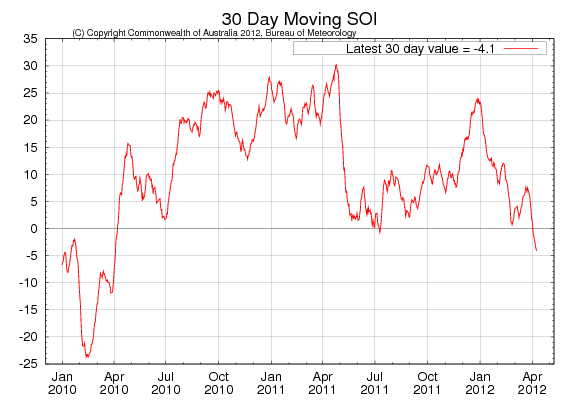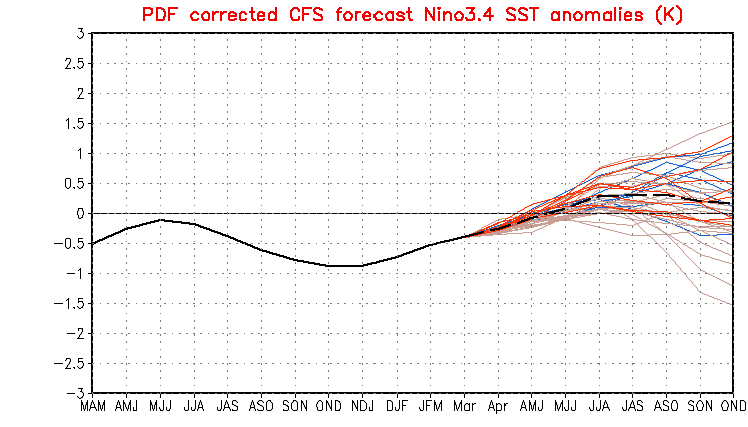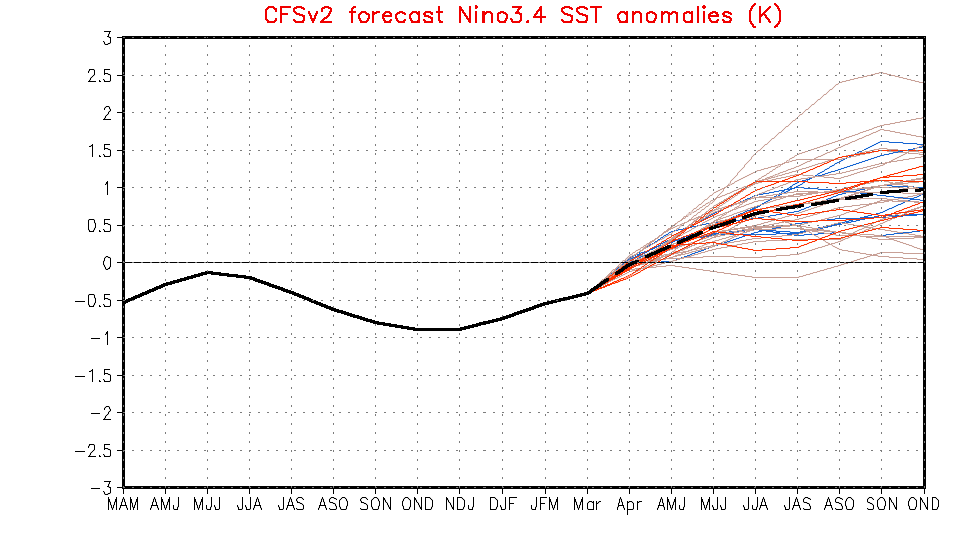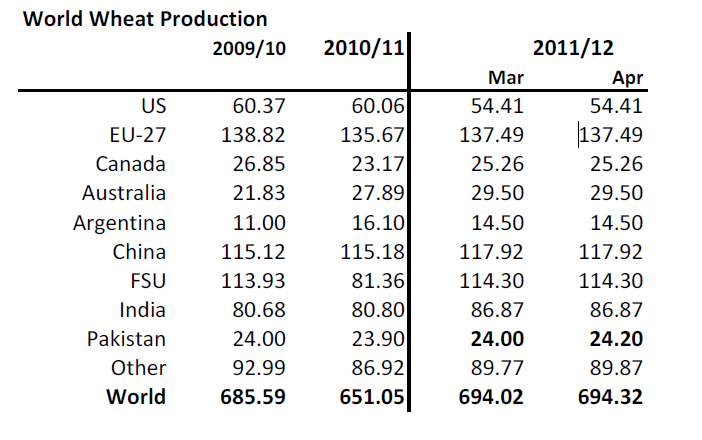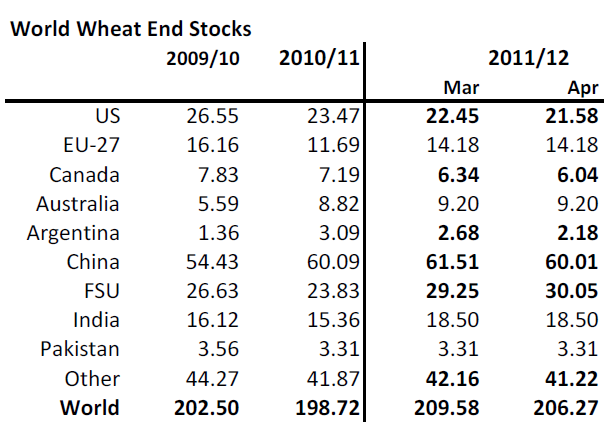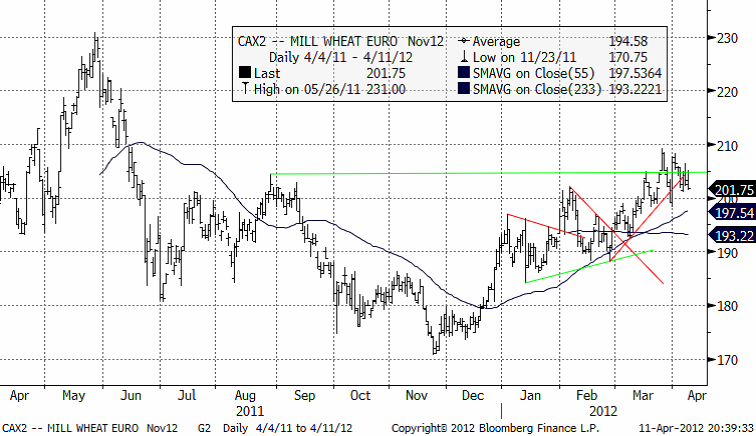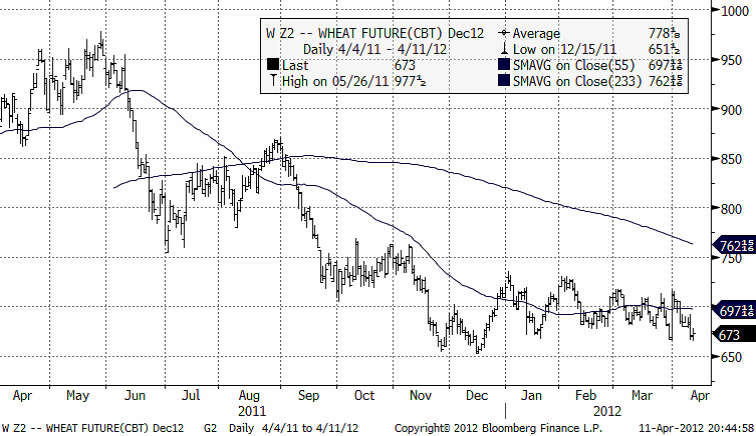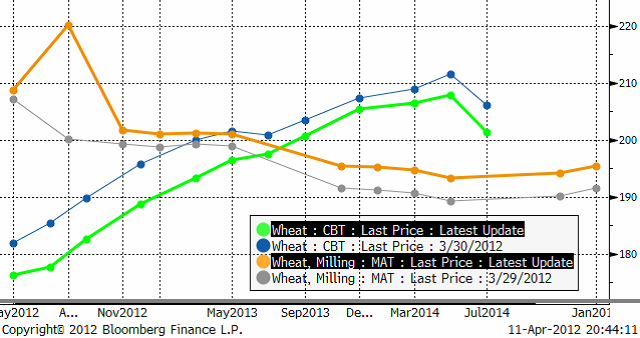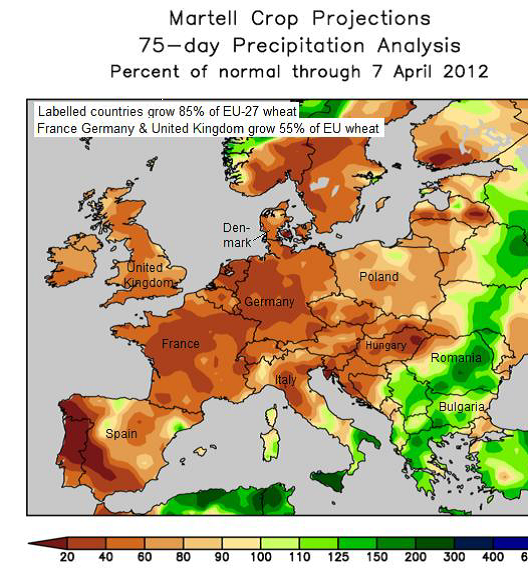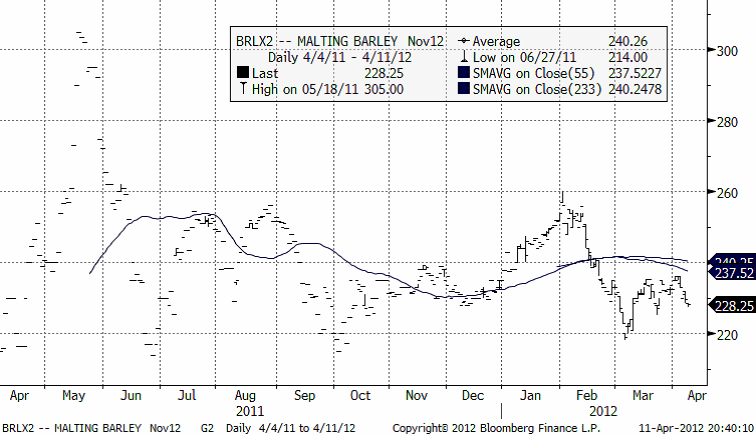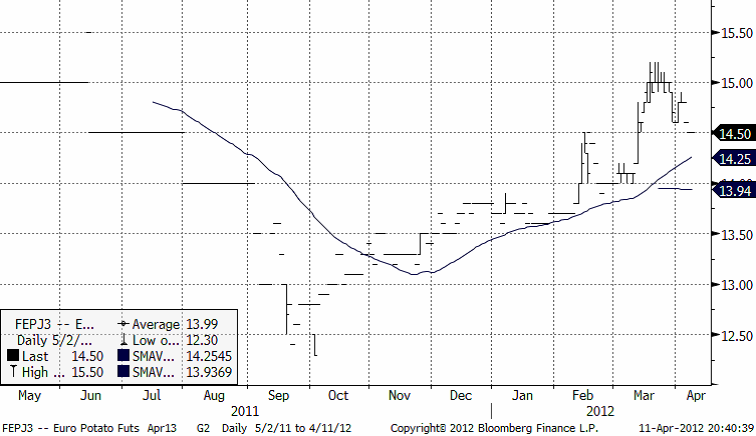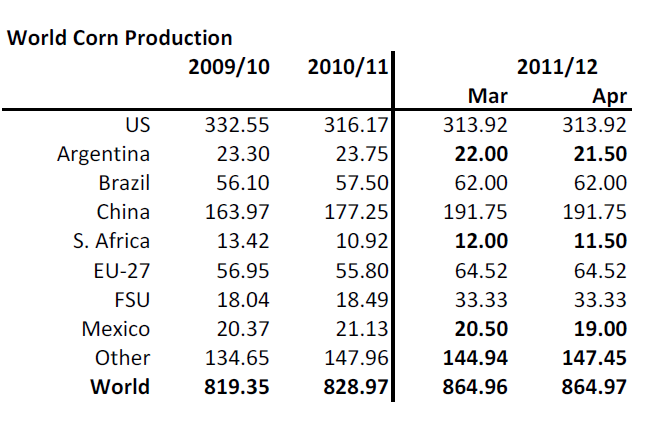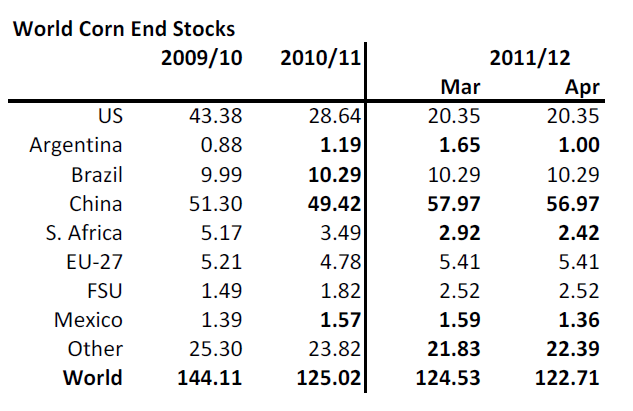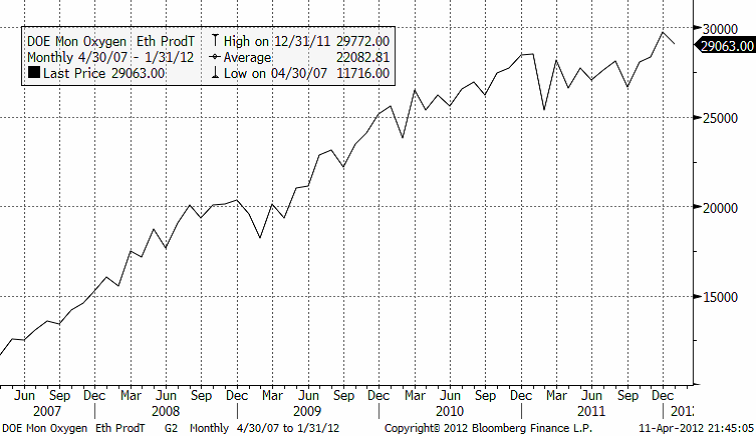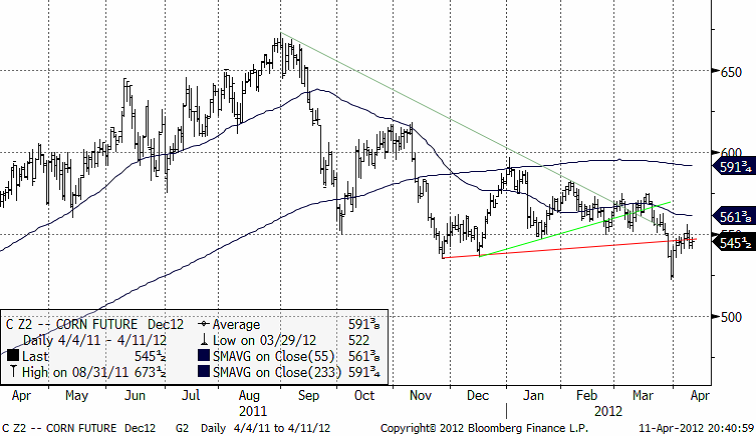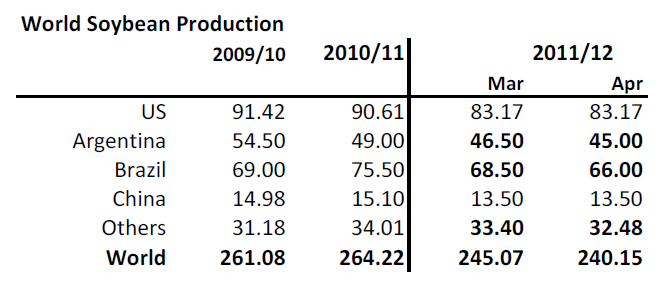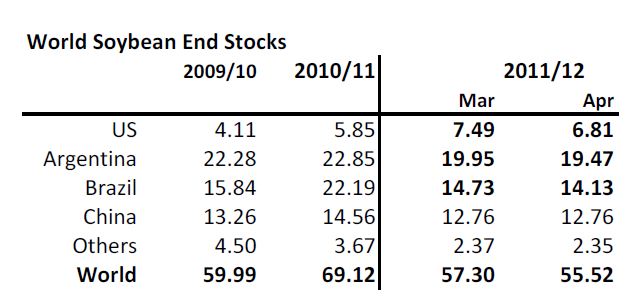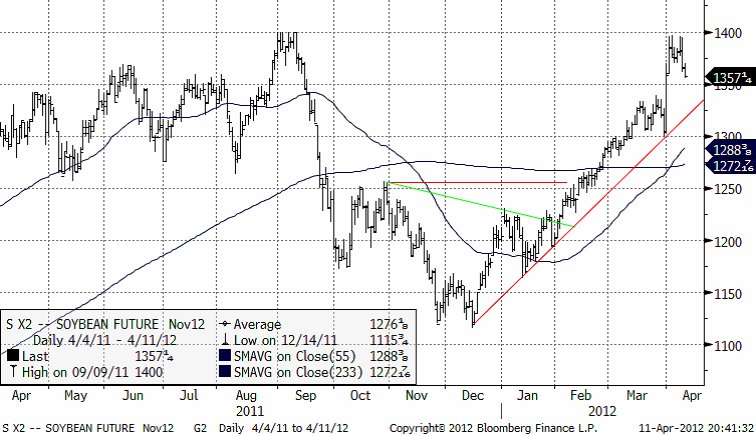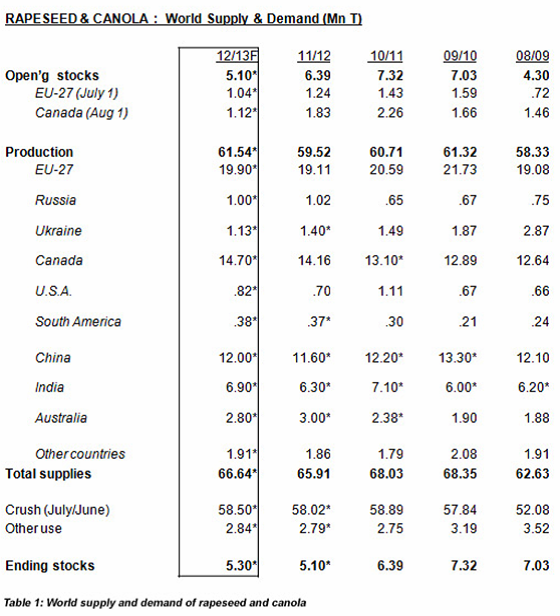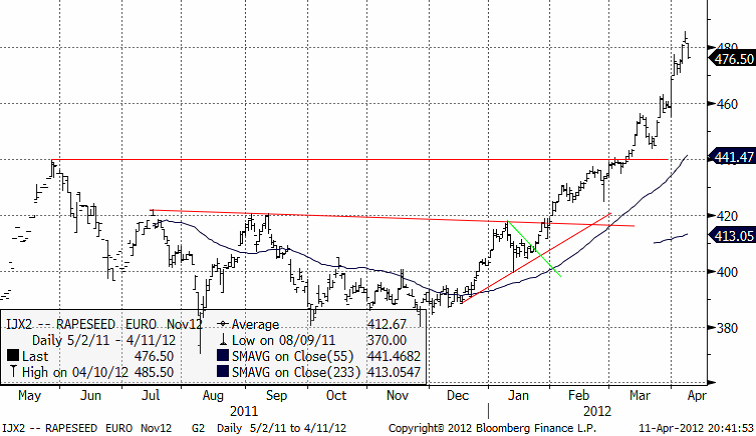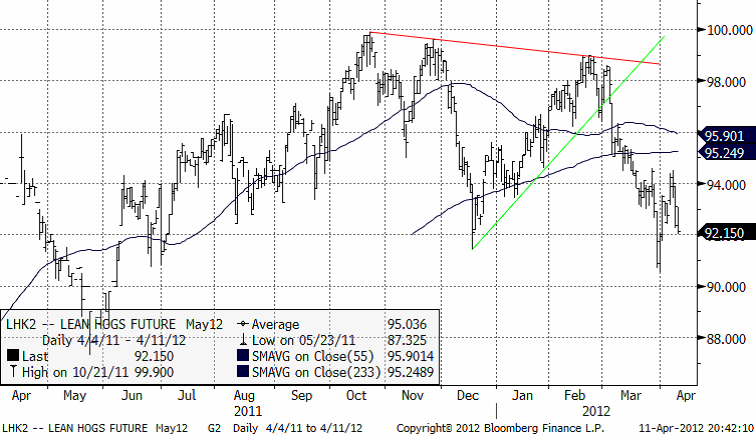Analys
SEB – Jordbruksprodukter, vecka 15 2012
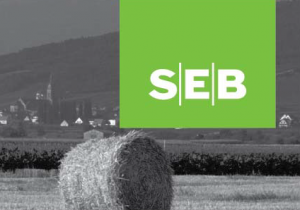 Vetepriset i USA har fallit med 5% sedan förra veckan. Bakom ligger flera faktorer, bland annat bättre väder. I omvärlden noterar vi en ny uppgång i räntorna i Spanien, en ny våg av misstro som vi inte sett sedan november förra året. Vi noterar att arbetsmarknaden i USA utvecklas svagt, enligt fredagens statistik.
Vetepriset i USA har fallit med 5% sedan förra veckan. Bakom ligger flera faktorer, bland annat bättre väder. I omvärlden noterar vi en ny uppgång i räntorna i Spanien, en ny våg av misstro som vi inte sett sedan november förra året. Vi noterar att arbetsmarknaden i USA utvecklas svagt, enligt fredagens statistik.
Sentimentet på aktiemarknaderna runt om i världen är rejält svagt. Kina, den stora motorn bakom råvaruboomen tycks hacka. Man kan tänka sig att sämre ekonomi i världen dämpar efterfrågan på mat. Den korrelationen är dock svag. Det viktigaste just nu tycker vi är utvecklingen av ENSO, som vi börjar brevet med.
Odlingsväder
Nedan ser vi Southern Oscillation Index, som mäter ENSO och indikerar La Niña om SOI > +8 och El Niño om SOI < -8. Vi ser att SOI minskat från +0.3 förra veckan till -4.1 i dagens rapport. Det är den lägsta nivån sedan mars för två år sedan. Prognoserna om ett möjligt El Niño och därmed vanligtvis följande superskörd ser ut att besanna
NOAA:s två senaste ensembleprognoser publicerades den 9 april den första är något högre, dvs något mer El Niño, medan den andra modellens prognoser ligger något lägre än de vi hade med i förra veckans veckobrev.
Nedan ser vi den andra modellen, CFS.v2, som också förutspår neutrala ENSO-förhållanden, men är kraftigare på El Niño-sidan för hösten.
Vete
Egypten, världens största importör av vete, har återigen köpt 115 000 ton av amerikanskt ursprung med leverans 21-31 maj enligt GASC.
[ Vinnande bud; USA; 55kt för 259.75$/t + frakt 24.00$/t från Alex Grain + 60kt för 259.75$/t + frakt 26.00$/t från Venus ]
WASDE-rapporten som publicerades av USDA i fredags visade inte på någon förändring alls vad gäller produktionsestimaten, som vi ser nedan.
Konsumtionen har justerats upp med 3 mt på global basis. Utgående lager sänks mest i Kina och i USA. Även Kanadas utgående lager sänks.
Det är väldigt små förändringar överlag. Rapporten ger ingen ny information att handla efter. Prisförändringarna blev också mycket små. Nedan ser vi novemberkontraktet på Matif. 210-nivån är ännu inte bruten, noterar vi.
Vi måste bara titta på Chicagokontraktet med ungefär samma löptid som Matifs novemberkontrakt. Decembervetet på CBOT har haft en helt annan prisutveckling de senaste månaderna än Matifkontraktet. När det har varit en prisuppgång på Matif har det varit ”sidledes” rörelse, till och med med en liten nedgång i USA.
Vän av ordning kanske då tänker på eurons svaga utveckling mot dollarn, men detta är inte hela förklaringen. I diagrammet nedan ser vi hur terminskurvorna för Chicagovete och Matifvete förändrat sig de senaste 7 handelsdagarna. Vi ser att Chicago fortsatt att falla, generellt. Matif har stigit, generellt. Som vanligt ser vi att augusti-kontraktet, detta illikvida kontrakt som snart ska försvinna, beter sig konstigt.
Utsikterna för den totala veteskörden i Europa ter sig dåliga just nu. Martell skriver den 9 april om torka, utvintring och dålig utveckling i östra Europa. Strategie Grains sänkte, som vi tidigare nämnt, estimaten för veteskörden i EU-27 förra månaden till 139.5 mt, vilket trots detta är 1.5% högre än förra året. Nedan ser vi nederbörden i förhållande till normalt för de senaste 75 dagarna i Europa.
Men vi måste komma ihåg att det troligtvis ser som sämst ut just nu. Med La Niña borta och kanske ett El Niño på väg att bildas kan vädret bli mycket bättre. Skörden i Europa har påverkats väldigt lite av vädret under januari till mars och mycket mer av vädret under maj, juni och juli. Utsikterna för detta ser mycket bättre ut.
Maltkorn
Novemberkontraktet på maltkorn ligger fortfarande under glidande medelvärden och det brukar tolkas negativt.
Potatis
Priset på industripotatis för leverans nästa år tog en paus efter förrförra veckans kraftiga prisuppgång. Priset har 15 euro som fixpunkt för den aktuella handeln.
Majs
Brasiliens produktion av majs för 2011/12 förväntas slå nytt rekord och Conab justerar upp sin prognos till 65.1 mt från 61.7 mt. Landet, som är världens tredje största producent av majs efter USA och Kina, producerade 57.4 mt majs under föregående skördeår.
Brasiliens skörd av majs (sommargröda) är nu till stor del avklarad och verkar bli något lägre till följd av det torra vädret, som också drabbat sojabönor. Däremot förväntas det gynnsamma vädret i centrala och västra delar av landet, som t.ex Mato Grosso, ge lantbrukare chansen att få ut det mesta möjliga av sin rekordstora sådd av majs som vintergröda (safrinha).
USDA verkar inte ha hängt med i svängarna här. De gjorde ingen justering av väntad produktion i Brasilien utan ligger kvar på 62 mt, 3mt under Conab. Vi tror mer på Conab. Allt annat lika borde det kunna innebära att global skörd, i USDA:s termer, är större, än vad man trodde förra månaden.
Konsumtionen i Kina justeras upp 1 mt av USDA. Bakom det ligger ett justerande av ingående lager, konsumtion och utgående lager, men i princip är innebörden att konsumtionen väntas öka med 1 mt.
USDA justerar ner etanolproduktionen i USA. Kritik mot detta har riktats mot USDA. Kritiken har menat att etanolproduktionen inte alls minskat i USA, men tillgänglig statistik stödjer USDA:s beslut.
Nedan ser vi etanolproduktionen per månad i 1000 fat i USA, enligt Department of Energys rapport. Den stora tillväxten i produktionen ligger bakom oss och hittills i år ser vi en nedgång i produktionen.
Prisreaktionen i decemberkontraktet på CBOT var en prisnedgång, som vi ser i nedanstående kursdiagram.
Vi går igång, trots allt, på den tekniska bilden. Rekylen upp mot 550 cent ser riktigt ”bearish” ut. Lite bättre väder i USA, lite lägre siffror i Southern Oscillation Index, och priset kan få en ordentlig skjuts nedåt.
Sojabönor
Brasilianska Conab publicerade en ny prognos för skördeåret 2011/12 igår. Skördeåret startade den 1 september och merparten redan har skördats. Conab justerade ner skördeprognosen till 65.6 mt från den tidigare uppskattningen på 68.7 mt som publicerades för en månad sedan och från 75.3 mt under föregående skördeår. Detta trots en ökning av areal med 3,4% till rekordhöga 25 miljoner hektar.
Odlare av sojabönor i Brasilien, världens näst största producent efter USA, kommer enligt Conab att skörda mindre än vad tidigare prognoser har visat efter att det torra vädret som associeras med La Nina har skadat grödor i landets södra delar, framförallt i regionerna Rio Grande do Sul och Parana där de största bortfallen väntas med 44 respektive 36 procent.
Torka har plågat flera av de södra sojabönsproducerande regionerna i Brasilien, Argentina och Paraguay, som tillsammans står för mer än hälften av världens handel med sojabönor. WASDE-rapporten från USDA justerade också ner skörden, med 2.5 mt och landar på ungefär samma siffra som Conab, 66 mt. Skörden i Argentina justeras också ner och tillsammans är de den största anledningen till att global produktion sänks med 5 mt i denna april månads rapport.
Konsumtionen i Sydamerika sänks med 2 mt vilket bidrar till att globala utgående lager bara sänks med drygt 2 mt.
Det var en klart ”bullish” rapport, men marknaden har valt att ta fasta på den negativa statistiken för global ekonomi (efterfrågesidan) som kom samtidigt och fick aktiemarknaderna att falla runtom i världen. Nederbörd i USA tycks också ge vatten på kvarnen för dem som pekat på att ett El Niño kan vara i antågande.
Tekniskt noterar vi att prisuppgången vände precis på 1400 cent, som lockade fram säljarna även vid toppen i september förra året.
Raps
Även om kanadensiska lantbrukare uppnår en rekordskörd av canola på 14.5-15 mt i slutet av sommaren 2012, är det stor sannolikhet att den globala produktionen av raps och canola inte kommer att kunna möte efterfrågan under 2012/13 – framförallt pga av dåliga utsikter för höstgrödorna i EU och Ukraina.
Oil World uppskattar en ökning av arealen för kanadensisk canola med 3-4% till en ny högsta nivå på 7.9 miljoner hektar (jämfört med 7.6 miljoner hektar i fjol). Canola har haft en fenomenal utveckling i Kanada och arealen har i stort sett fördubblats under en 10-årsperiod från 3.9 miljoner hektar under våren 2002. Som en följd av detta har dock produktionen av spannmål, framförallt korn och vete, minskat kraftigt.
Enligt preliminära prognoser kommer den globala produktionen av raps och canola att uppgå till 61.5 mt, vilket motsvarar en måttlig återhämtning på 2 mt från nuvarande säsong. Detta under förutsättningen gynnsamma väderförhållanden och ökad sådd i Kanada och Indien.
Nedan ser vi kursdiagrammet för novemberkontraktet, som gick upp över 480 euro per ton innan priset föll tillbaka och stängde på 476.5 euro igår, onsdag.
440 euro utgör nu, när den nivån är bruten, ett tekniskt stöd. Vi fortsätter därför att ha en neutral vy, om inte 440-nivån bryts igen.
Gris
Majkontraktet som steg till över 94 cent har nu fallit ner mot 92 cent, en stödnivå igen. Svagare ekonomisk statistik väcker oro för efterfrågan.
[box]SEB Veckobrev Jordbruksprodukter är producerat av SEB Merchant Banking och publiceras i samarbete och med tillstånd på Råvarumarknaden.se[/box]
Disclaimer
The information in this document has been compiled by SEB Merchant Banking, a division within Skandinaviska Enskilda Banken AB (publ) (“SEB”).
Opinions contained in this report represent the bank’s present opinion only and are subject to change without notice. All information contained in this report has been compiled in good faith from sources believed to be reliable. However, no representation or warranty, expressed or implied, is made with respect to the completeness or accuracy of its contents and the information is not to be relied upon as authoritative. Anyone considering taking actions based upon the content of this document is urged to base his or her investment decisions upon such investigations as he or she deems necessary. This document is being provided as information only, and no specific actions are being solicited as a result of it; to the extent permitted by law, no liability whatsoever is accepted for any direct or consequential loss arising from use of this document or its contents.
About SEB
SEB is a public company incorporated in Stockholm, Sweden, with limited liability. It is a participant at major Nordic and other European Regulated Markets and Multilateral Trading Facilities (as well as some non-European equivalent markets) for trading in financial instruments, such as markets operated by NASDAQ OMX, NYSE Euronext, London Stock Exchange, Deutsche Börse, Swiss Exchanges, Turquoise and Chi-X. SEB is authorized and regulated by Finansinspektionen in Sweden; it is authorized and subject to limited regulation by the Financial Services Authority for the conduct of designated investment business in the UK, and is subject to the provisions of relevant regulators in all other jurisdictions where SEB conducts operations. SEB Merchant Banking. All rights reserved.
Analys
A sharp weakening at the core of the oil market: The Dubai curve

Down to the lowest since early May. Brent crude has fallen sharply the latest four days. It closed at USD 64.11/b yesterday which is the lowest since early May. It is staging a 1.3% rebound this morning along with gains in both equities and industrial metals with an added touch of support from a softer USD on top.

What stands out the most to us this week is the collapse in the Dubai one to three months time-spread.
Dubai is medium sour crude. OPEC+ is in general medium sour crude production. Asian refineries are predominantly designed to process medium sour crude. So Dubai is the real measure of the balance between OPEC+ holding back or not versus Asian oil demand for consumption and stock building.
A sharp weakening of the front-end of the Dubai curve. The front-end of the Dubai crude curve has been holding out very solidly throughout this summer while the front-end of the Brent and WTI curves have been steadily softening. But the strength in the Dubai curve in our view was carrying the crude oil market in general. A source of strength in the crude oil market. The core of the strength.
The now finally sharp decline of the front-end of the Dubai crude curve is thus a strong shift. Weakness in the Dubai crude marker is weakness in the core of the oil market. The core which has helped to hold the oil market elevated.
Facts supports the weakening. Add in facts of Iraq lifting production from Kurdistan through Turkey. Saudi Arabia lifting production to 10 mb/d in September (normal production level) and lifting exports as well as domestic demand for oil for power for air con is fading along with summer heat. Add also in counter seasonal rise in US crude and product stocks last week. US oil stocks usually decline by 1.3 mb/week this time of year. Last week they instead rose 6.4 mb/week (+7.2 mb if including SPR). Total US commercial oil stocks are now only 2.1 mb below the 2015-19 seasonal average. US oil stocks normally decline from now to Christmas. If they instead continue to rise, then it will be strongly counter seasonal rise and will create a very strong bearish pressure on oil prices.
Will OPEC+ lift its voluntary quotas by zero, 137 kb/d, 500 kb/d or 1.5 mb/d? On Sunday of course OPEC+ will decide on how much to unwind of the remaining 1.5 mb/d of voluntary quotas for November. Will it be 137 kb/d yet again as for October? Will it be 500 kb/d as was talked about earlier this week? Or will it be a full unwind in one go of 1.5 mb/d? We think most likely now it will be at least 500 kb/d and possibly a full unwind. We discussed this in a not earlier this week: ”500 kb/d of voluntary quotas in October. But a full unwind of 1.5 mb/d”
The strength in the front-end of the Dubai curve held out through summer while Brent and WTI curve structures weakened steadily. That core strength helped to keep flat crude oil prices elevated close to the 70-line. Now also the Dubai curve has given in.

Brent crude oil forward curves

Total US commercial stocks now close to normal. Counter seasonal rise last week. Rest of year?

Total US crude and product stocks on a steady trend higher.

Analys
OPEC+ will likely unwind 500 kb/d of voluntary quotas in October. But a full unwind of 1.5 mb/d in one go could be in the cards

Down to mid-60ies as Iraq lifts production while Saudi may be tired of voluntary cut frugality. The Brent December contract dropped 1.6% yesterday to USD 66.03/b. This morning it is down another 0.3% to USD 65.8/b. The drop in the price came on the back of the combined news that Iraq has resumed 190 kb/d of production in Kurdistan with exports through Turkey while OPEC+ delegates send signals that the group will unwind the remaining 1.65 mb/d (less the 137 kb/d in October) of voluntary cuts at a pace of 500 kb/d per month pace.

Signals of accelerated unwind and Iraqi increase may be connected. Russia, Kazakhstan and Iraq were main offenders versus the voluntary quotas they had agreed to follow. Russia had a production ’debt’ (cumulative overproduction versus quota) of close to 90 mb in March this year while Kazakhstan had a ’debt’ of about 60 mb and the same for Iraq. This apparently made Saudi Arabia angry this spring. Why should Saudi Arabia hold back if the other voluntary cutters were just freeriding? Thus the sudden rapid unwinding of voluntary cuts. That is at least one angle of explanations for the accelerated unwinding.
If the offenders with production debts then refrained from lifting production as the voluntary cuts were rapidly unwinded, then they could ’pay back’ their ’debts’ as they would under-produce versus the new and steadily higher quotas.
Forget about Kazakhstan. Its production was just too far above the quotas with no hope that the country would hold back production due to cross-ownership of oil assets by international oil companies. But Russia and Iraq should be able to do it.
Iraqi cumulative overproduction versus quotas could reach 85-90 mb in October. Iraq has however steadily continued to overproduce by 3-5 mb per month. In July its new and gradually higher quota came close to equal with a cumulative overproduction of only 0.6 mb that month. In August again however its production had an overshoot of 100 kb/d or 3.1 mb for the month. Its cumulative production debt had then risen to close to 80 mb. We don’t know for September yet. But looking at October we now know that its production will likely average close to 4.5 mb/d due to the revival of 190 kb/d of production in Kurdistan. Its quota however will only be 4.24 mb/d. Its overproduction in October will thus likely be around 250 kb/d above its quota with its production debt rising another 7-8 mb to a total of close to 90 mb.
Again, why should Saudi Arabia be frugal while Iraq is freeriding. Better to get rid of the voluntary quotas as quickly as possible and then start all over with clean sheets.
Unwinding the remaining 1.513 mb/d in one go in October? If OPEC+ unwinds the remaining 1.513 mb/d of voluntary cuts in one big go in October, then Iraq’s quota will be around 4.4 mb/d for October versus its likely production of close to 4.5 mb/d for the coming month..
OPEC+ should thus unwind the remaining 1.513 mb/d (1.65 – 0.137 mb/d) in one go for October in order for the quota of Iraq to be able to keep track with Iraq’s actual production increase.
October 5 will show how it plays out. But a quota unwind of at least 500 kb/d for Oct seems likely. An overall increase of at least 500 kb/d in the voluntary quota for October looks likely. But it could be the whole 1.513 mb/d in one go. If the increase in the quota is ’only’ 500 kb/d then Iraqi cumulative production will still rise by 5.7 mb to a total of 85 mb in October.
Iraqi production debt versus quotas will likely rise by 5.7 mb in October if OPEC+ only lifts the overall quota by 500 kb/d in October. Here assuming historical production debt did not rise in September. That Iraq lifts its production by 190 kb/d in October to 4.47 mb/d (August level + 190 kb/d) and that OPEC+ unwinds 500 kb/d of the remining quotas in October when they decide on this on 5 October.

Analys
Modest draws, flat demand, and diesel back in focus

U.S. commercial crude inventories posted a marginal draw last week, falling by 0.6 million barrels to 414.8 million barrels. Inventories remain 4% below the five-year seasonal average, but the draw is far smaller than last week’s massive 9.3-million-barrel decline. Higher crude imports (+803,000 bl d WoW) and steady refinery runs (93% utilization) helped keep the crude balance relatively neutral.

Yet another drawdown indicates commercial crude inventories continue to trend below the 2015–2022 seasonal norm (~440 million barrels), though at 414.8 million barrels, levels are now almost exactly in line with both the 2023 and 2024 trajectory, suggesting stable YoY conditions (see page 3 attached).
Gasoline inventories dropped by 1.1 million barrels and are now 2% below the five-year average. The decline was broad-based, with both finished gasoline and blending components falling, indicating lower output and resilient end-user demand as we enter the shoulder season post-summer (see page 6 attached).
On the diesel side, distillate inventories declined by 1.7 million barrels, snapping a two-week streak of strong builds. At 125 million barrels, diesel inventories are once again 8% below the five-year average and trending near the low end of the historical range.
In total, commercial petroleum inventories (excl. SPR) slipped by 0.5 million barrels on the week to ish 1,281.5 million barrels. While essentially flat, this ends a two-week streak of meaningful builds, reflecting a return to a slightly tighter situation.
On the demand side, the DOE’s ‘products supplied’ metric (see page 6 attached), a proxy for implied consumption, softened slightly. Total demand for crude oil over the past four weeks averaged 20.5 million barrels per day, up just 0.9% YoY.
Summing up: This week’s report shows a re-tightening in diesel supply and modest draws across the board, while demand growth is beginning to flatten. Inventories remain structurally low, but the tone is less bullish than in recent weeks.


-

 Nyheter4 veckor sedan
Nyheter4 veckor sedanEurobattery Minerals satsar på kritiska metaller för Europas självförsörjning
-

 Nyheter3 veckor sedan
Nyheter3 veckor sedanMahvie Minerals i en guldtrend
-

 Nyheter4 veckor sedan
Nyheter4 veckor sedanGuldpriset kan närma sig 5000 USD om centralbankens oberoende skadas
-

 Nyheter4 veckor sedan
Nyheter4 veckor sedanOPEC signalerar att de inte bryr sig om oljepriset faller kommande månader
-

 Analys3 veckor sedan
Analys3 veckor sedanVolatile but going nowhere. Brent crude circles USD 66 as market weighs surplus vs risk
-

 Nyheter3 veckor sedan
Nyheter3 veckor sedanAktier i guldbolag laggar priset på guld
-

 Nyheter3 veckor sedan
Nyheter3 veckor sedanKinas elproduktion slog nytt rekord i augusti, vilket även kolkraft gjorde
-

 Nyheter2 veckor sedan
Nyheter2 veckor sedanTyskland har så höga elpriser att företag inte har råd att använda elektricitet


